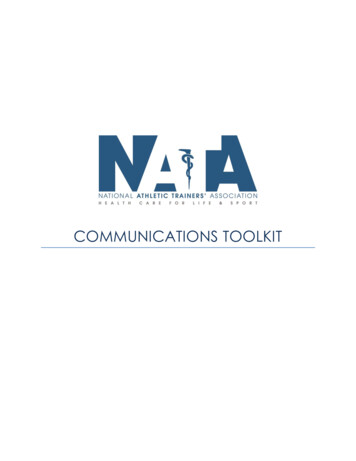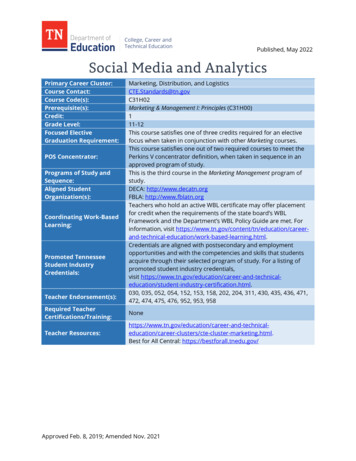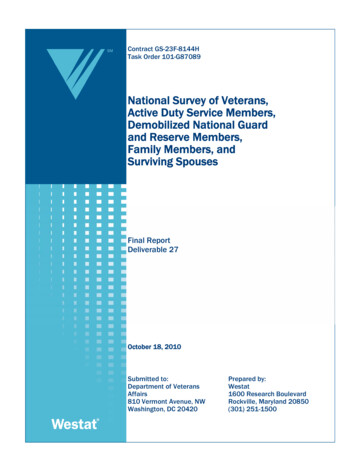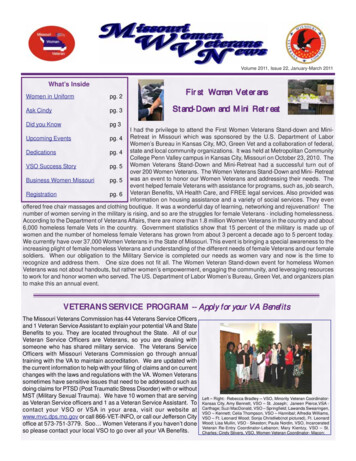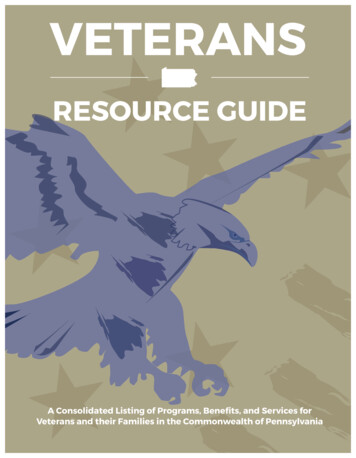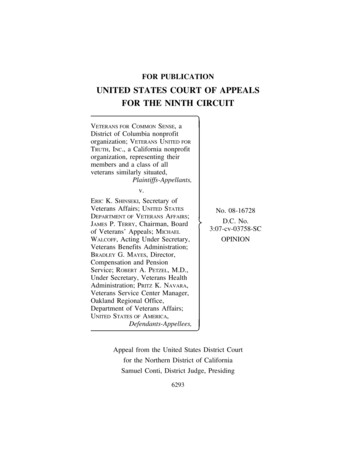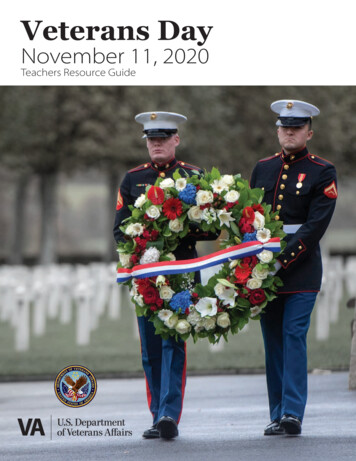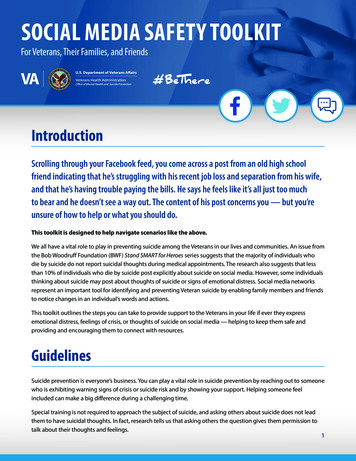
Transcription
SOCIAL MEDIA SAFETY TOOLKITFor Veterans, Their Families, and FriendsIntroductionScrolling through your Facebook feed, you come across a post from an old high schoolfriend indicating that he’s struggling with his recent job loss and separation from his wife,and that he’s having trouble paying the bills. He says he feels like it’s all just too muchto bear and he doesn’t see a way out. The content of his post concerns you — but you’reunsure of how to help or what you should do.This toolkit is designed to help navigate scenarios like the above.We all have a vital role to play in preventing suicide among the Veterans in our lives and communities. An issue fromthe Bob Woodruff Foundation (BWF) Stand SMART for Heroes series suggests that the majority of individuals whodie by suicide do not report suicidal thoughts during medical appointments. The research also suggests that lessthan 10% of individuals who die by suicide post explicitly about suicide on social media. However, some individualsthinking about suicide may post about thoughts of suicide or signs of emotional distress. Social media networksrepresent an important tool for identifying and preventing Veteran suicide by enabling family members and friendsto notice changes in an individual’s words and actions.This toolkit outlines the steps you can take to provide support to the Veterans in your life if ever they expressemotional distress, feelings of crisis, or thoughts of suicide on social media — helping to keep them safe andproviding and encouraging them to connect with resources.GuidelinesSuicide prevention is everyone’s business. You can play a vital role in suicide prevention by reaching out to someonewho is exhibiting warning signs of crisis or suicide risk and by showing your support. Helping someone feelincluded can make a big difference during a challenging time.Special training is not required to approach the subject of suicide, and asking others about suicide does not leadthem to have suicidal thoughts. In fact, research tells us that asking others the question gives them permission totalk about their thoughts and feelings.1
Social Media Safety Toolkit for Veterans, Their Families, and FriendsNo matter how casually or jokingly stated, comments about emotional distress, crisis, or suicide should always betaken seriously. Someone who talks about suicide, or who shares concerning images on social media, providesothers with an opportunity to intervene before suicidal behaviors occur.According to University of Utah research portrayed in BWF Stand SMART for Heroes, Veterans who died bysuicide were more likely to: Post about stressful events and then immediately talk about emotional distress and negative thoughts. Talk about alcohol consumption or post pictures involving alcoholic beverages. Post content that rapidly switched back and forth between positive emotional content and negativeemotional content. Post pictures of personal firearms but not of friends and pets.How to Recognize and Respond to EmotionalDistress on Social MediaThe following example language includes signs of emotional distress: Hopelessness: “Nothing I do makes a bit of a difference. It’s beyond my control.” Direct statements about suicide: “I’m having thoughts of suicide.” “I’m thinking about hurting myself.” Feeling trapped: “I can’t see any way out of this mess. Life will never get better.” Feeling like a burden: “They’d be better off without me.” “I’d be better off dead.” Lack of belonging: “No one cares. I just don’t fit in anywhere.” Guilt: “It’s all my fault. I’m to blame.” Saying goodbye or desire to escape: “I just wanted to tell everyone thank you for all you’ve done, but I justcan’t take this anymore.” Feeling alone: “I’m on my own. No one cares about me.”2
Social Media Safety Toolkit for Veterans, Their Families, and FriendsSample Posts and Tweets That IndicateEmotional DistressThe following posts and tweets exhibit signs of emotional distress:“I suffer with PTSD and hearing loss. Every day is astruggle and I can barely walk. I can’t handle thesefeelings forever.”“The sad thing about this, is I asked for help and keptgetting doors slammed in my face, being laughedat, and pushed aside, and forgotten about. I wasmessed over by the college I chose, they chargedmore for my degree and I am getting no help fromanyone, on that as well. I am fighting 3 differentbattles just to keep my family where we are becausemy credit score does not allow me to get a decentjob that I went to school for.”“I have been a veteran for over 40 years and nota damn soul has helped me out. I am a serviceconnected disabled vet and it has been an uphill,lonely battle by myself.”“When I returned I thought I was fine for a secondthen every night waking up crazy scaring the crapout of everyone, anger out of control and all theelements playing over and over.”3
Social Media Safety Toolkit for Veterans, Their Families, and FriendsSample Responses to Posts and Tweets ThatIndicate Emotional DistressResponses like the ones below can make a big difference to a Veteran in emotional distress and may even save a life.Facebook@ screen name: In tough times you can feellike you are battling life all on your own. OtherVeterans have felt this way too. Whether youjust returned from a combat deployment orexperienced another kind of traumatic event,it’s never too late to get professional treatmentor support. Find resources near you to help:https://maketheconnection.net/resources@ screen name: As a Veteran, I am really sorry toread what you are going through. It sounds likea really difficult time. There are resources in yourcommunity that can help. Use the VA resourcelocator at resources to find local resources forVeterans, such as Suicide Prevention Coordinators,Crisis Centers, and Vet Centers in your community.@ screen name: I read your post, and it soundslike you are really hurting right now. Click the linkbelow to find resources and support from peoplewho care and who can help you through this.Visit the Suicide Prevention Lifeline website elfto find local mental health professionals and supportgroups and learn how to make a safety plan.Twitter@ screen name: As a Veteran, it concerns me tohear you are going through this. Other Veteranshave felt this way too. Click the following linkto find resources and support from peoplewho care and who can help you through this.https://maketheconnection.net/resources@ screen name: In tough times you can feellike you are battling life all on your own. Thereare resources in your community that can help.Use the VA resource locator to find local SuicidePrevention Coordinators, Crisis Centers, and VetCenters. esources@ screen name: It sounds like you are really hurtingright now. Visit the Suicide Prevention Lifelinewebsite to find local mental health professionalsand support groups and learn how to make a safetyplan. 4
Social Media Safety Toolkit for Veterans, Their Families, and FriendsHow to Recognize and Respond to Signs onSocial Media of a Potential CrisisPosts and tweets that include discussion of the following behaviors are signs of a potential crisis and requireimmediate attention: Thinking about hurting or killing oneself Looking for ways to kill oneself Talking about death, dying, or suicide Self-destructive behavior, such as drug abuse, weapon use, etc.Everyone has a role to play when it comes to preventing Veteran suicide. If you notice someone on social mediaexhibiting signs of a potential crisis, don’t wait for somebody else to take action. Follow these steps:1. Contact the Veterans Crisis Line at 1-800-273-8255 and Press 1. Do this regardless of whether there is animmediate threat of suicide or harm to others.2. Reply to the post with one of the safe messaging examples provided in this toolkit‚ which include informationon the Veterans Crisis Line and the National Suicide Prevention Lifeline.3. Report the post to the social media platform, using the resources provided in this toolkit.Reporting Suicidal Content on Facebook Facebook – Suicide Prevention: View Facebook’s recommendations for what to do if you see suicidalcontent on the platform. Facebook – Report Suicidal Content: Fill out this form to report suicidal content found on Facebook.5
Social Media Safety Toolkit for Veterans, Their Families, and FriendsReporting Suicidal Content on Twitter Twitter – About Self-Harm and Suicide: View Twitter’s recommendations for what to do if you see suicidalcontent on the platform. Twitter – Report Self-Harm: Fill out this form to report suicidal content found on Twitter.Sample Posts and Tweets That Indicatea Possible Crisis“I live with the feeling that I should have died inViet Nam instead of others”“Still Suffer from nightmares, night sweats, awakescreaming and yelling from my sleep, think of suicideall the time, but being a part time Reservist, I donot get VA benefits, I live with the evil since cominghome 2006. Have no family, wife died in 2010, andall alone. Have major health problems, wish I had mylife back, but it’s gone, I am glad others are gettingwell, I am 50 years old and well soon it will be time togo to heaven.”“No help for me in my state. No one specializes inDID or MDD, to name a few of my labels. I’m givingup as everytime I go, the billing department thinksafter two visits, I should be cured. Cleaning myhouse out and getting things in order. When I’ve hadenough, I’m outta here. Abusers dead, children andfriends shunned me. Fine. I get it. Too much for themto handle. How do they think I feel about it. Theydon’t care. Got blindsided by it. I don’t care anymore.My only regret is that I didn’t run in front of a buswhen I got diagnosed”“I understand I am a Viet Nam veteran and I livealone. Sometimes I wonder, what’s the use of living ifmy children do not talk to me”6
Social Media Safety Toolkit for Veterans, Their Families, and FriendsSample Responses to Posts and Tweets ThatIndicate a Possible CrisisResponses like the ones below can make a big difference to a Veteran in crisis and may even save a life.Facebook@ screen name: I’ve dealt with those thoughtstoo, and I can tell you that treatment works. Knowthat help and support are available from peoplewho care and who can help you through this.Call the Veterans Crisis Line at 1-800-273-8255and Press 1, text to 838255, or chat online atVeteransCrisisLine.net/Chat. A responder will talkwith you anonymously.@ screen name: It concerns me to hear about whatyou’re going through. Know that you are not aloneand there is support that can help. Call the VeteransCrisis Line at 1-800-273-8255 and Press 1, text to838255, or chat online at VeteransCrisisLine.net/Chat. A responder will talk with you anonymously.@ screen name: I’m sorry to hear you are hurtinglike this. It sounds like a difficult time. OtherVeterans have felt this way too. There are peoplewho can help. Call the Veterans Crisis Line at 1-800273-8255 and Press 1, text to 838255, or chat onlineat VeteransCrisisLine.net/Chat. A responder willtalk with you anonymously.Twitter@ screen name: It concerns me to hear about whatyou’re going through. You are not alone, and thereis help. Call the Veterans Crisis Line at 1-800-2738255 and Press 1, text to 838255, or chat online atVeteransCrisisLine.net/Chat.@ screen name: I’m sorry to hear you arehurting like this. Things can and will get better.Call the Veterans Crisis Line at 1-800-273-8255and Press 1, text to 838255, or chat online atVeteransCrisisLine.net/Chat.@ screen name: You are not alone. Call the VeteransCrisis Line at 1-800-273-8255 and Press 1, text to838255, or chat online at VeteransCrisisLine.net/Chat. You can also send a text message tothem at 838255. A responder will talk with youanonymously.7
Social Media Safety Toolkit for Veterans, Their Families, and FriendsSocial Media Suicide Prevention Resources Social Media Guidelines for Mental Health Promotion and Suicide Prevention: Follow these tips forcommunicating about mental health and suicide on social media to help reduce stigma and increase helpseeking. Support for Suicidal Individuals on Social and Digital Media: This toolkit from the National SuicidePrevention Lifeline helps digital community managers and social media platforms establish safety policies forhelping individuals in suicidal crisis.Additional Suicide Prevention Resources Veterans Crisis Line: If you or someone you know is in crisis, connect with the Veterans Crisis Line to reachcaring, qualified responders. Contact the Veterans Crisis Line at 1-800-273-8255 and Press 1, chat online atVeteransCrisisLine.net/Chat, or send a text message to 838255. #BeThere: These tips and tools can help you show your support for Veteran friends and family members andstart the conversation about suicide prevention. Coaching Into Care: Coaching Into Care is a national telephone service from VA that aims to educate,support, and empower family members and friends who are seeking care or services for a Veteran. Make the Connection: MakeTheConnection.net is an online VA resource designed to connect Veterans,their family members and friends, and other supporters with information, resources, and solutions to issuesaffecting their lives. PsychArmor S.A.V.E Training: This training is designed to help anyone who interacts with Veterans learn toidentify the Signs of suicide, Ask questions, Validate the Veteran’s experience, and Escort the Veteran to careand Expedite treatment. VA Resource Locator: Hosted by the Veterans Crisis Line, the resource locator connects you with localsupport available through VA, the National Resource Directory, and behavioral health treatment services fromthe Substance Abuse and Mental Health Services Administration. Action Alliance Framework for Successful Messaging: This framework helps people develop messagesabout suicide prevention that are strategic, safe, and positive and that make use of relevant guidelines andbest practices.8
Social Media Safety Toolkit for Veterans, Their Families, and Friends Bob Woodruff Foundation’s “How to Use Social Media Patterns to Identify Veterans At Risk for Suicide”:This study suggests that social media platforms represent an important and valuable tool for identifying andpreventing Veteran suicide. Recommendations for Reporting on Suicide and Recommendations for Blogging on Suicide: These sitesoffer recommendations for safely reporting on suicide to maximize the effectiveness of communications andreduce the risk of harmful effects stemming from unsafe messaging.Anyone can help prevent Veteran suicide.Anyone can help prevent Veteran suicide. Your actions can make a lifesaving difference when you reach outto a family member or friend you are concerned about and provide resources that can help. As you scroll onsocial media, look out for warning signs of suicide risk that are outlined in this toolkit, and follow the steps toprovide support for the Veterans in your life and your community.9
Social edia afety Toolkit for Veterans, Their Families, and Friends 4. Sample Responses to Posts and Tweets That . Indicate Emotional Distress . Responses like the ones below can make a big difference to a


